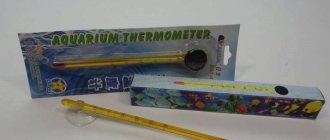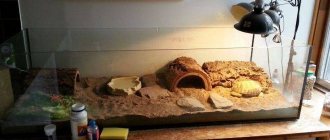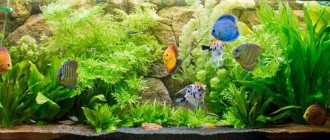To maintain the normal functioning of aquarium inhabitants, it is necessary to select special equipment. Air aeration is very important; it makes the water suitable for all inhabitants. For this purpose, use an aquarium sprayer. In order for the device to work effectively, you should pay attention to its characteristics when choosing.
Air aeration is very important; it makes the water suitable for all inhabitants.
Purpose
An aquarium sprayer is used to supply air to an artificial reservoir, which is pumped by a compressor and supplied to the device through a hose under pressure. Through small holes in the nozzle it is released into the water in the form of bubbles.
Aeration is necessary to saturate the water with oxygen. Fish and other aquarium inhabitants often experience a lack of oxygen due to overcrowding. The accumulation of large amounts of aquatic waste in water, high water temperature, as well as the great depth of the reservoir, combined with a small surface area, reduce the ability of atmospheric oxygen to dissolve in water. Lack of oxygen and excessive accumulation of carbon dioxide lead to illness and death of aquarium inhabitants.
In addition, the air entering the reservoir from the compressor constantly mixes the water in the container. This helps to equalize the temperature and prevents stagnation of water, saturated with waste from the inhabitants of the aquarium, in any one part of the artificial reservoir. This ensures protection of aquatic organisms from temperature shock and poisoning by organic decay products.
On a note! Sometimes sprayers are used as a decorative element of an aquarium. Small air bubbles rising along the back wall can become a real decoration for an artificial pond.
Purpose of the device
An air atomizer for an aquarium is a very simple device. It provides normal living conditions for fish and other organisms, and is also a beautiful decoration for the underwater world. In addition, small air bubbles look gorgeous against the general background .
This equipment saturates the aquarium with oxygen. With its help, layers of water move, the temperature is equalized and the desired balance is achieved in the reservoir, in which its inhabitants feel cozy and comfortable. With a large number of fish and other organisms, such a device is simply necessary.
An aquarium atomizer with fine bubbles quickly atomizes the air and enriches the aquatic environment with oxygen , suppressing carbon dioxide. And the hose of the device creates an original effect in the form of a kind of curtain. Everything together makes the aquarium harmonious, attracting attention to the exotic underwater world at home. This makes it look more dynamic and alive.
The numerous useful features of the aquarium sprayer are a great addition to the rest of your equipment. It is an indispensable device for providing fish and other aquatic organisms with comfortable water for living.
Main advantages
The compressor, together with an air sprayer for an aquarium, performs a number of functions that no other type of equipment can cope with:
- saturation of water with oxygen;
- equalization of temperature by mixing layers of water;
- prevention of water stagnation and poisoning of aquatic organisms by accumulated waste products;
- creating a current necessary for some species of aquarium inhabitants;
- reduction of point water pressure on hydrobionts;
- giving a decorative appearance to an artificial reservoir.
Varieties
There are two types of aquarium sprayers on sale: those made from natural materials and artificial ones. The first ones are made from special porous stones that can allow air to pass through, breaking it into small bubbles. Stone products are environmentally friendly and do not spoil the natural design of the aquarium, but they have one drawback - the noise created during operation. Therefore, aquarists often opt for artificial atomizer options.
Artificial products can have different shapes and are made from various materials (rubber, plastic, etc.). Most often in aquariums, especially large ones, flexible sprayers made of soft rubber with many small holes are used. It is easy to give such products the desired shape and place them in the required place of an artificial reservoir - on the bottom, wall, along joints or decorative elements.
Other types of artificial sprays - disk, ring or in the form of decorations - are used less frequently. Disk products are a flat disk made of porous material, the entire surface area of which releases air bubbles. Ring versions differ from disk ones by the presence of a hole in the middle. Large diameter rings are convenient to place around decorations or plant pots, creating an unusual design using a curtain of air bubbles.
Figurative devices in the form of chests, boats and other objects usually perform a purely decorative function in an aquarium. They often release too large air bubbles, which poorly oxygenate the water. The structural elements of such sprayers very quickly become clogged with silt and soil particles, food can get into them, and aquarium snails can also get into them. Therefore, these devices require regular cleaning. It is not recommended to use them as the only source of oxygen in an aquarium; you should combine the figurines with any other type of atomizer that will cover the oxygen needs of the aquarium inhabitants.
Aquarium sprayer and everything you need to know about it
A quality aquarium sprayer should be dense enough to produce fine bubbles. And its pores should not clog too quickly. The most common sprayers are in the form of short cylinders made of abrasive materials. But they have excessively large bubbles. Better quality aquarium sprayer made from white whetstone. But both of them are suitable for equipping the vast majority of even the most low-power air pumps. They can be easily camouflaged by placing them on the ground and pressing them down with something heavy, for example, a piece of lead.
And their price is quite low. Dense ceramic atomizers are much more effective. But only pumps that develop a pressure of at least 1000–1500 mm of water column can cope with them. Every self-respecting company's instructions for its microcompressor say what pressure it develops. If it is 1000 or more millimeters, feel free to take a ceramic sprayer. They cost a little more and are less common on shelves, but they are able to produce fairly small bubbles.
Long tubular synthetic sprayers (Penn-Plax, etc.) are very good. The color and shape make it easy to disguise them in thickets of plants (they are attached to a smooth surface with suction cups), and the bubbles can be both small and large, thanks to the regulator air supply on the hose. Tubular sprayers are available in lengths from 20 to 60 centimeters, which means you can choose a sprayer specifically for your aquarium. And a long wall of bubbles creates active water movement even in a very large home pond.
Which aquarium sprayer is best?
There are two main types of air diffusers for aquariums: those made from natural materials and those made from artificial ones. The first ones are made of special porous stones, which allow a stream of air to pass through them, crushing it into many small bubbles that escape into the water. Such sprayers are the most environmentally friendly, but their disadvantage is the noise they produce during operation. Therefore, most people who have aquariums, and especially those who have them in the bedroom, choose the second type of sprayer.
They are made of soft rubber with holes through which air escapes. These nozzles are much quieter and often come in the form of long strips that can be spread across the bottom of the aquarium to ensure even gas saturation of the water. This sprayer option is also ideal for use in large aquariums designed for large volumes of water.
Although quite powerful and large compressors are produced, designed for large aquariums, experienced breeders suggest using not one, but several sprayers located in different areas of the bottom. Although it is not recommended to bury them in the ground, as this speeds up the clogging of the holes in the material, many still do this to give their aquarium a more aesthetically pleasing spring look.
Design of aquarium sprayers
Aquarium sprayers can have a wide variety of shapes: cylindrical, elongated, square, rectangular. You should choose exactly the size and shape that is best suited for your volume of water, and will also fit well into the bottom topography and underwater landscape created in the aquarium.
In addition to simple sprayers designed only to perform their main function, there are also special decorative sprayers for aquariums that are complex in design. They can take the form of a variety of objects or decorations made from baked clay: treasure chests, old vases, ships, pieces of wood. A sprayer is mounted inside each such figure, to which the compressor hose is attached.
When they work, it seems that air bubbles come from these objects. When using decorative sprayers, the appearance of the aquarium not only does not suffer, but even acquires a certain originality and individuality, since the choice of one or another figure depends only on the buyer’s imagination.
Another interesting option is backlit aquarium sprayers. They are equipped with special LEDs that create a uniform glow or periodic color changes. They can look like standard spray options or as decorative ones with one more additional opportunity to decorate the aquarium.
Thanks to such sprayers, even at night, your home pond will look unusual and beautiful, and the location of such sprayers will give the aquarium individuality and special beauty. With the help of light, you can place accents in the “interior” of the aquarium, attract attention to plants or figures on the bottom, and the whole environment will only emphasize the beauty of the fish living in such an unusual aquarium.
AQUARIUM PUMP AND EVERYTHING YOU NEED TO KNOW ABOUT IT.
CO2 FOR AQUARIUM WITH YOUR OWN HANDS PHOTO VIDEO DESCRIPTION.
BACKGROUND FOR AQUARIUM PHOTO VIDEO DETAILED DESCRIPTION.
CO2 FOR AQUARIUM AND EVERYTHING YOU NEED TO KNOW ABOUT IT.
Criterias of choice
To choose the best aquarium sprayer, you need to determine what it will be used for. When choosing equipment you need to pay attention to the following points:
- Power. This indicator depends on the size and configuration of the product and is determined by the number of air bubbles emerging from a unit surface area of the device. Power shows how quickly the aquarium will be saturated with oxygen. For large containers, it is recommended to choose long and wide rectangular products.
- The noise made by the device during operation. This aspect is especially important when the aquarium is in the bedroom or nursery. The noise increases if there is no soil in the aquarium and the sprayer is located directly on the glass, or if the amount of soil under the product is insufficient.
- Possibility of disassembling the device for cleaning in case of contamination. Since the device is usually placed at the bottom of the reservoir, over time the holes in it become clogged with silt or soil particles. If the device cannot be disassembled and cleaned from the inside, it must be replaced with a new one.
- Hole size. Aquarium sprayers can have both large and small holes. When choosing a device, you should take into account that sprayers with small bubbles saturate the water with oxygen more effectively.
- Appearance. Pet stores offer a large selection of sprayers of all possible shapes and colors. Thanks to this, you can choose an option that suits any aquarium design.
Types of equipment
Sprayers are mandatory items for aquarium equipment. With the help of a compressor, small bubbles are formed, which then enter the water through a sprayer.
There are many types of sprayers:
- flexible (plastic);
- point;
- in the form of decorations;
- disk.
Each of them has its own purpose, for example, a flexible rubber device is mainly used for large containers. It consists of long tubes that can easily be placed in a spacious aquarium.
Stone ones are used in all types of aquariums. However, they have a significant drawback - noisy operation. This feature must be taken into account if the tank is located in the bedroom or children's room. It will make more noise if there is insufficient soil in the container or a shallow bottom.
Main advantages
Without an air sprayer for an aquarium, it will not be possible to achieve high-quality aeration. And a lack of oxygen will lead to a decrease in the immunity of the inhabitants of the container and, as a result, to diseases. But such devices are multifunctional and improve various processes in water tanks:
- effectively mix layers of water, preventing it from stagnating, and also remove harmful gases;
- average the temperature;
- the filter picks up all the dirt from the bottom;
- create the current necessary for most species of marine life.
The air flows created help reduce point pressure on all aquarium life, including plants. In addition, no large waves arise during the operation of the device. And to cover the tube, special weights are used, which help hide it in the container.
Lack of oxygen will lead to a decrease in the immunity of the inhabitants of the tank and, as a result, to diseases.
How to make an aquarium sprayer with your own hands
Aquarium sprayers sold in stores are often expensive and have a short lifespan. Therefore, many aquarists prefer to make them themselves from available materials. To do this you will need the following materials and tools:
- small diameter rubber hose;
- tee;
- stationery knife;
- stand (you can use a kitchen board).
A piece of the required length is cut from the hose. A tee is inserted into one end of the hose and the other end of the hose is attached to it to form a ring. Holes are made in the hose using a utility knife or other sharp object. In this case, the largest number of holes should be in the part remote from the tee. Near the tee, the number of holes should be small, as should their diameter. This will allow air to flow evenly through the entire sprayer.
After a sufficient number of holes have been made, a compressor hose is connected to the free end of the tee and the device is placed in the aquarium. Having turned on the air supply, evaluate the power of the resulting device and, if necessary, add more holes.











